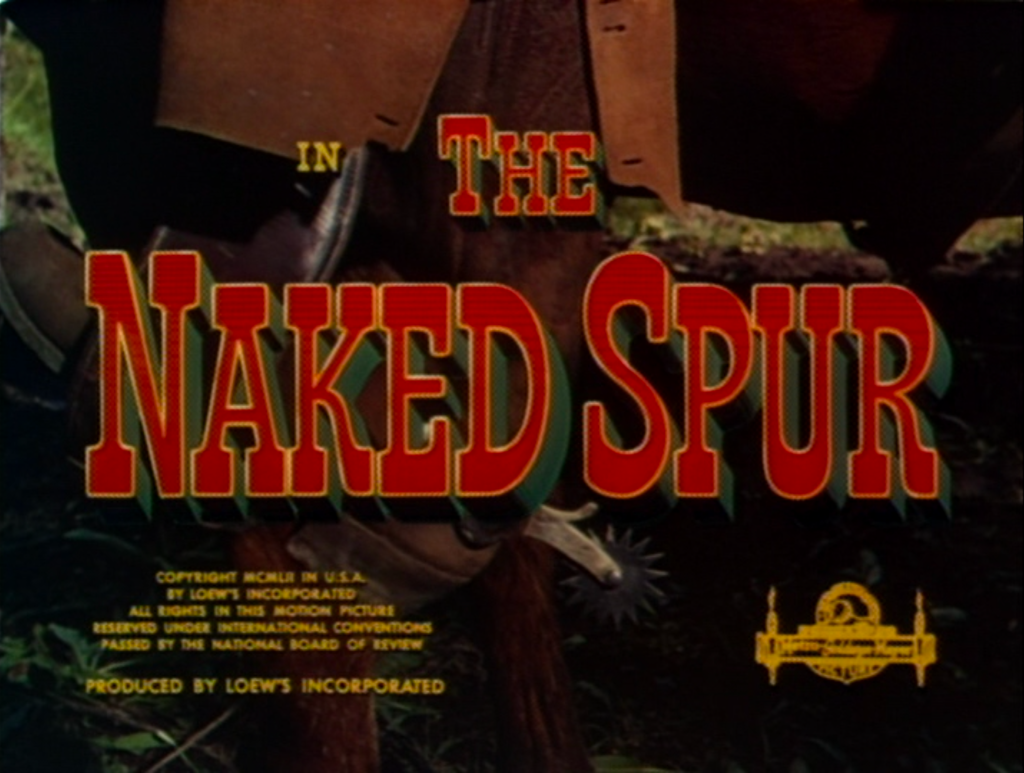JIMMY STEWART MANNS UP AGAIN

The film’s been covered on this site twice before, once by the venerable Ed Howard in 2013 and once by Mr. Fish himself in his 2009 roundup of the fifty greatest ‘50s films. At number 38, Allan implicitly concedes it is average among the greats of that decade, yet calls The Naked Spur (in the comments of that entry) his favorite from among the five brilliant Westerns made by director Anthony Mann and his cowboy surrogate Jimmy Stewart. Together they blacksmithed out a cycle that parsed the actor’s apparently deep reservoir of anger and bitterness into a new trademark that made dark seem light in any of his previous popular performances (even the soulful misery of It’s a Wonderful Life) while sowing the ground quite generously for later dives into his vulgar darkness, mostly worked out by Hitchcock in Rear Window (1954) – which proved that Stewart did indeed have his perverse side – but of course expanded to its fullest by Hitch in ’58’s Vertigo. But that film’s revelation could not have had the all-consuming resonance it did had Stewart not already shown us his coiled – then uncoiled – rage in Mann’s string of down-and-dirty Westerns Winchester ’73 (1950), Bend of the River (1952), this movie in ’53, The Far Country (1954), and The Man From Laramie (1955). These all combine to utterly re-mold our concept of Stewart from a pleasantly passionate rustic into a three-dimensional manifestation of sometimes not-so-righteous anger. In any case, Allan’s masterful breakdown of the movie, in his inimitably brief style, should be enough to christen it “covered”, but I’ve wanted to unpack it ever since it cantered its way into my personal top ten, some fifteen years ago. And this yearly tribute has given me the perfect (selfish) opportunity to figure out a few of the things that make me love it so much.

Bronislau Kaper’s urgent opening trumpet music is like that of a high adventure story or even an urban thriller, but is set against the tranquil images of man on horse in the open country, forcing us to consider the possibly fractured peace of this cowboy’s ride. The picture of Stewart’s lone wanderer ka-lopping forward, unidentified, mysterious, small on screen, shrunk by his wilderness surroundings, is a common enough sight in the opening strains of classic Westerns that a short list of its kin comes readily to mind. To name a few: The Searchers (1956), The Tall T (1957), and most iconically, Shane, from the same year as this film. By then it’s already a trope… not that it doesn’t get even more mileage through the decades – there’s the introduction of Angel Eyes in The Good, The Bad and the Ugly (1966) and Eastwood’s own avenging angel in High Plains Drifter (1973), among many others. But evil or good, we’re conditioned by our own assumption of rugged individualism to self-flatter identification with the man who hacks out a life of solitude amongst the wild bramble and sloping hills and monolithic blue skies of unspoiled America as if he owns all of it. That presumption is the essence of the myth of how we got here and the even bigger myth of who we still think we are. We want to believe it, so we give ourselves over to the cowboy’s story.
(more…)





















 Click on names for archives
Writers/Founders
Click on names for archives
Writers/Founders